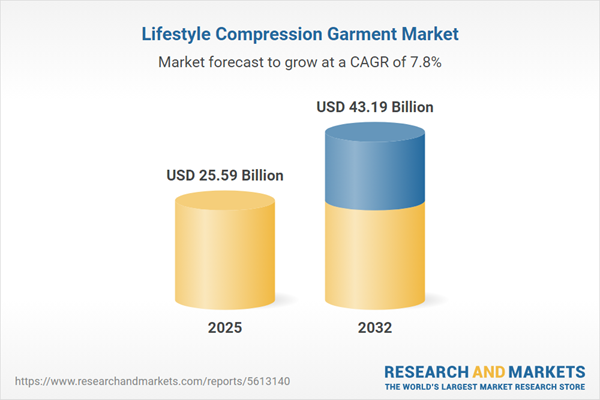Speak directly to the analyst to clarify any post sales queries you may have.
The lifestyle compression garment market is rapidly redefining expectations for performance, comfort, and design, with senior executives actively seeking reliable intelligence to unlock competitive advantages and optimize their strategies in an evolving landscape.
Lifestyle Compression Garment Market Snapshot
Global demand for lifestyle compression garments is accelerating, supported by a market valued at USD 23.71 billion and anticipated near-term growth to USD 25.59 billion. Projections estimate the sector will reach USD 43.19 billion by 2032, maintaining a notable CAGR of 7.78%. This performance highlights sustained interest from diverse customer bases spanning healthcare, wellness, and sports. Leading brands are integrating medical-grade innovations into consumer-oriented aesthetics, leveraging technology to bridge practical function with contemporary design. This approach enables companies to address increasingly sophisticated user demands and expand adoption into new application areas, reinforcing their positions through forward-looking product strategies.
Scope & Segmentation
This comprehensive report supplies actionable B2B intelligence for business leaders aiming to recalibrate product development, strategic planning, and procurement processes. Market structure analysis is organized by the following core categories, bringing clarity to growth opportunities and channel strategies:
- Applications: Includes daily lifestyle use, medical rehabilitation, fitness, and athletic contexts, giving brands the flexibility to diversify across general well-being and targeted therapeutic solutions.
- Product Types: Features compression leggings, shirts, shorts, sleeves, and socks, specially engineered for ergonomic support across professional and recreational activities.
- Material Types: Centers on advanced blends such as nylon-spandex and polyester-elastane, regarded for their durability, flexibility, and user comfort even over extended use periods.
- End Users: Evaluates adoption trends among male and female consumers, spotlighting industry developments in inclusive sizing and representation for broader demographic coverage.
- Distribution Channels: Covers B2B platforms, retail outlets, pharmacies, specialty shops, proprietary e-commerce channels, and third-party online operators for enhanced market penetration.
- Regions Profiled: Surveys the Americas, Europe, Middle East & Africa, and Asia-Pacific, considering logistics, compliance, and growth trajectories unique to each territory.
- Key Companies Highlighted: Profiles leadership and innovation initiatives from Nike, Adidas, Lululemon, Under Armour, Hanesbrands, Puma, Spanx, 2XU, McDavid, and Skims, with a focus on technological and design advancements in the category.
Lifestyle Compression Garment Market: Key Takeaways
- The market is shifting focus beyond athletics by expanding into rehabilitation and holistic fitness, enabling brands to diversify their offerings and enter new revenue streams.
- Investment in seamless garment technology and technical fiber integration is creating differentiated product lines with heightened comfort and durability, which strengthen customer loyalty.
- Omnichannel marketing initiatives, including digital and physical sales as well as influencer engagement, are deepening institutional and end-user relationships.
- Firms are prioritizing procurement transparency and compliance in sourcing, which enhances supplier trust and reduces operational and reputational risks.
- Design strategies emphasizing inclusivity and adaptability are capturing previously overlooked consumer segments and responding to shifting societal and demographic preferences.
- Adoption of intelligent sizing technologies and accelerated product cycles is supporting quicker adaptation to market trends and evolving user needs.
Tariff Impact
Recent changes in U.S. tariff regulations are prompting a strategic reassessment of supply chain models. Organizations with domestic or vertically integrated sourcing are experiencing greater pricing stability and operational control. Conversely, businesses that depend on international suppliers are diversifying sourcing strategies and refining inventory management to sustain continuity and minimize risk exposure in an evolving regulatory environment.
Methodology & Data Sources
The analysis is derived from executive-level interviews, extensive sector input, global trade data, and up-to-date regulatory information. To ensure actionable insights, methodologies incorporate Porter’s Five Forces and SWOT frameworks, supporting executive decision-making with a structured view of industry dynamics.
Why This Report Matters
- Arms senior decision-makers with market intelligence covering digital transformation, compliance protocols, and omnichannel marketing to inform planning and operational execution.
- Offers structured risk assessment and strategic frameworks to navigate safe expansion across both domestic and global arenas.
- Provides benchmarking methodologies that guide effective market positioning within a volatile and competitive global environment.
Conclusion
Sustained success in the lifestyle compression garment market depends on continual strategic responsiveness and ongoing product innovation. Comprehensive data equips leaders to identify emerging opportunities and reinforce resilient value chains.
Additional Product Information:
- Purchase of this report includes 1 year online access with quarterly updates.
- This report can be updated on request. Please contact our Customer Experience team using the Ask a Question widget on our website.
Table of Contents
3. Executive Summary
4. Market Overview
7. Cumulative Impact of Artificial Intelligence 2025
Companies Mentioned
The companies profiled in this Lifestyle Compression Garment market report include:- Nike, Inc.
- Adidas AG
- Lululemon Athletica, Inc.
- Under Armour, Inc.
- Hanesbrands Inc.
- Puma SE
- Spanx, Inc.
- 2XU Pty Ltd
- McDavid, LLC
- Skims HQ LLC
Table Information
| Report Attribute | Details |
|---|---|
| No. of Pages | 184 |
| Published | October 2025 |
| Forecast Period | 2025 - 2032 |
| Estimated Market Value ( USD | $ 25.59 Billion |
| Forecasted Market Value ( USD | $ 43.19 Billion |
| Compound Annual Growth Rate | 7.7% |
| Regions Covered | Global |
| No. of Companies Mentioned | 11 |









